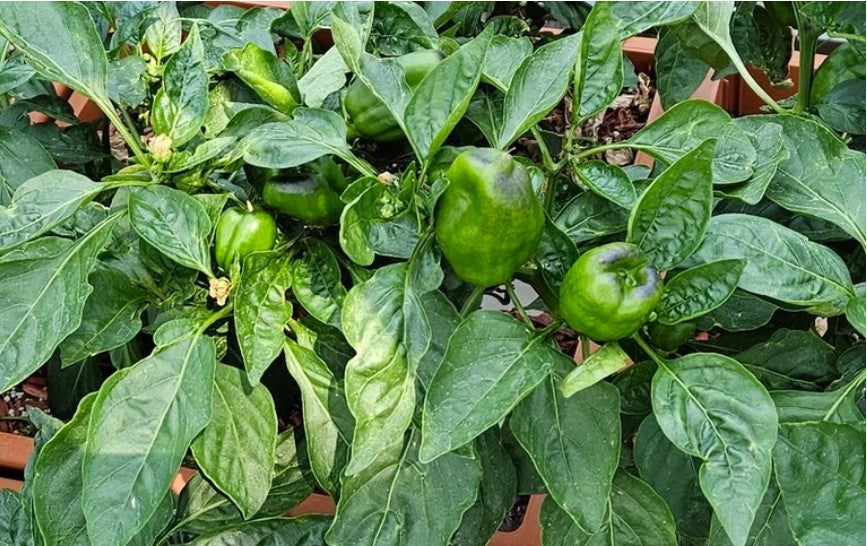Ever bitten into a pepper so crisp and flavorful it made your taste buds dance? That's the magic of perfectly grown greenhouse peppers.
But here's the catch—it takes more than just planting seeds and hoping for the best. With just a little guidance and the proper care, you can cultivate these delicious vegetables all season long.
Ready to transform your greenhouse into a pepper paradise? Whether a seasoned gardener or a curious beginner, this guide will walk you through the essential techniques for growing peppers that burst with flavor.
Let’s dive in!

1. Choose the Right Pepper Varieties
Did you know there are over 50,000 pepper varieties? From sweet bell peppers to fiery habaneros, the world of capsicums is incredibly diverse.
Each pepper type has unique light, temperature, and care requirements.
That’s why choosing the right pepper variety for greenhouse cultivation is crucial for maximizing yields:
- Bell Peppers: Known for their sweet flavor and versatility in cooking, they come in various colors like red, yellow, and orange.
- Jalapeños: A favorite for those who enjoy a bit of heat, jalapeños add spice to dishes and are prized for their robust flavor.
- Banana Peppers: These mild and slightly tangy peppers are great for pickling or adding a subtle kick to salads and sandwiches.


2. Create Optimal Greenhouse Conditions
Turn your greenhouse for vegetables into a pepper heaven by fine-tuning your greenhouse's environmental conditions! Here’s how to ensure your peppers thrive:
- Temperature Control: For healthy growth, maintain a consistent range of 70°F to 85°F (21°C to 29°C) during the day and slightly cooler at night using ventilation techniques.
- Humidity Management: Keep humidity levels around 60-70% to prevent issues like blossom end rot and fungal diseases.
- Light Requirements: Ensure peppers get 6-8 hours of sunlight daily; use greenhouse grow lights for robust fruit development.

3. Focus on Soil and Nutrition
Happy peppers start from the ground up. Here's how to give them the best nutrition for them to thrive:
- Blend your soil cocktail and ensure a pH between 6.0 and 6.8. Combine potting soil, perlite, and compost for a light base that peppers love.
- Feed your plants every few weeks. Use a balanced plant food or try organic options like fish emulsion or worm tea.
- Calcium boost: Sprinkle crushed eggshells around your plants to prevent blossom end rot and strengthen stems.
4. Use Effective Watering Techniques
Proper hydration is essential for cultivating thriving pepper plants in your greenhouse, as it enhances both plant health and productivity.
- Install a drip irrigation system for optimal results. This method delivers water directly to the root zone, minimizing waste and reducing the risk of foliar diseases.
- Consistency is vital in your watering regimen. Pepper plants flourish when soil moisture is maintained at an ideal level - neither oversaturated nor parched.
- Water quality should not be overlooked. Utilizing filtered or collected rainwater can prevent the buildup of potentially harmful salts and chemicals in the soil.
- Regular soil moisture monitoring is essential. We suggest implementing a systematic approach to assess when additional watering is necessary.

Images from Planta Greenhouses’ customers.
5. Pest and Disease Management
Maintaining a healthy pepper crop requires vigilance and proactive measures against potential threats:
- Regular Monitoring: Implement a systematic inspection routine to detect issues early.
- Beneficial Insects: Introduce natural predators like ladybugs or predatory mites to control harmful pests. These tiny allies reduce pest populations and contribute to a more sustainable and balanced greenhouse ecosystem.
- Physical Barriers: Use fine mesh screens on vents and openings to prevent pest entry.
- Climate Control: Maintain optimal temperature and humidity levels to discourage pest proliferation and disease development. For example, high humidity can promote fungal diseases such as powdery mildew, while excessively low humidity can lead to issues like blossom end rot.
Common Threats and Solutions for Peppers
- Aphids: Combat with insecticidal soaps or neem oil applications.
- Powdery Mildew: Improve air circulation and apply fungicides when necessary.
- Blossom End Rot: Address through proper calcium nutrition and consistent watering practices.


Cultivate Your Pepper Paradise
By implementing these greenhouse techniques, you're well on your way to growing the most flavorful and bountiful pepper crop imaginable.
By following these expert tips, you can transform your greenhouse from a simple growing space into a pepper production powerhouse!
Ready to take your pepper growing to the next level? Read our detailed guides or check out our premium greenhouse kits to grow the perfect peppers!
Why Nova Greenhouses?
- We handpick high-quality greenhouses from the best brands in the world.
- Our team works hard to find extraordinary backyard greenhouses at reasonable price points.
- We exclusively source premium products made from the finest materials.
- Our team tests every greenhouse to guarantee strength & durability.
- We have a vast shipping network that reaches every corner of Canada & the USA.
- Our top-rated customer care team is available 7-days a week to answer any questions.

